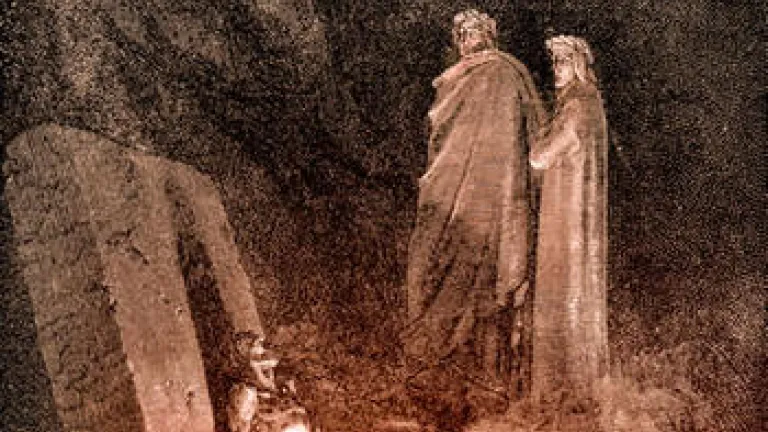A Kinder, Gentler Hell?
As opinions about hell have changed over the years, so have the teachings of many churches. But what does the Bible say?
Syncretism—the combination of differing beliefs and practices—has long been a hallmark of mainstream Christianity. Centuries ago church leaders set aside biblically assigned days of worship in favor of Sunday, Christmas and Easter. Similarly, popular tradition long ago replaced the biblical teaching about hell.
Beliefs about hell are changing again. A recent poll revealed a dramatic shift in opinion among Americans regarding concepts of hell. True to historical form, major religious organizations are adjusting their teachings accordingly. The recent beliefs and teachings concerning the fate of sinners could be called a “kinder, gentler” hell.
According to U.S. News & World Report, in 1997 the majority belief among U.S. citizens was that “hell is a real place where people suffer eternal fiery torments.” Just a few years later 53 percent believed “hell is an anguished state of existence eternally separated from God” (“Hell Hath No Fury,” Jeffrey Sheler, Jan. 31, 2000, p. 47).
This shift in thinking can be attributed to several factors. “Lampooned by modern intellectuals and increasingly sidelined by preachers preferring to dwell on more uplifting themes, the threat of post-mortem punishment of the impenitent in an eternal lake of fire all but disappeared from the religious mainstream by the 1960s. Theological discourse on the subject at the nation’s divinity schools almost evaporated. And while polls showed that the majority of Americans professed to believe in hell’s existence, almost no one thought he would go there” (ibid.).
The reasoning behind the shift often paints punishment as a childish fear tactic that is no longer valid or needed by mature adults. Others reason that a good God couldn’t possibly punish people forever, as that would be against His very nature. “‘Once we discovered we could create hell on Earth,’ says John Dominic Crossan, professor emeritus at DePaul University in Chicago, ‘it became silly to talk about it in a literal sense’” (ibid., p. 50).
Authenticating this modern interpretation for Roman Catholics, Pope John Paul II stated that “rather than a place, hell indicates the state of those who freely and definitely separate themselves from God.” In so doing he described hell as something figuratively portrayed in the Bible as a “pool of fire” or a “second death” (ibid., p. 45).
The recent beliefs and teachings concerning the fate of sinners could be called a “kinder, gentler” hell.
Catholic funeral masses have changed to reflect this view. White priestly garments have replaced black ones, and prayers such as Dies Irae (Day of Wrath), which describe the torture of the wicked, have been set aside in favor of ones dealing with hope and the resurrection.
In concert with this socially driven change, “the doctrine commission of the Church of England recently recommended a hell of ‘final and irrevocable choosing of that which is opposed to God’ instead of medieval fire and torment. And the newest Presbyterian catechism hardly mentions the subject at all... Even among evangelicals, hell as a subject from the pulpit is less ubiquitous than before” (USA Today, “Churches Give Hell a Makeover,” Gerald Zelizer, Feb. 21, 2000, p. 15A).
The modern religious consumer
In an effort to explain recent changes in teachings about hell, Gerald Zelizer, rabbi of a Conservative congregation serving Jewish residents of Metuchen and Edison, New Jersey, offers three reasons he believes hell is being refashioned. First is the religious consumer’s view that he needs positive things, including love, hope, peace and marriage enrichment, more than being saved from hell. Second is the American psyche, which thinks people are entitled to be happy and successful. Third is ambiguity within Christianity over what Matthew meant when he said that evildoers would be “cast into a furnace of fire.”
Consumer
In an age of consumer-driven markets, churches are not only striving to meet the individual where he stands emotionally and intellectually but are adjusting doctrines to attract and retain people. Theologians and parishioners regularly adjust doctrinal positions to fit their changing perspectives. Jesus Christ’s first-century condemnation of substituting “the commandments of men” for the teachings of God (Matthew 15:9; Mark 7:7) has gone unheeded.
Yet strangely, some theologians paint their revisions as honorable, carefully thought-out methods of taking the gospel to contemporary culture. Thomas Reese, editor of the Jesuit journal America, reasons that today’s gentler hell, based on relationships and psychological experiences such as loneliness, wouldn’t have made sense to earlier generations.
U.S. News & World Report’s religion writer Jeffrey Sheler notes that this most recent change in the view of hell is similar to other changes in Christian teaching. But not everyone agrees with such humanly devised changes of biblical teachings.
The history of change
Evangelical Protestants and conservative Catholics (who comprise much of the 34 percent of Americans who hold to the traditional view that hell is a literal place of eternal punishment) do not accept the kinder, gentler hell.
Yet ironically, many of those resistant to the recent change are unaware that their “traditional” beliefs are nothing more than revisions of the true biblical teaching. The major difference lies in the fact that their revisions were made many centuries ago.
Theologians and parishioners regularly adjust doctrinal positions to fit their changing perspectives. So where did the idea of hell as a place of eternal punishment come from?
Surprising as it may sound, the idea of hell as a literal place where evildoers are punished for eternity did not arise until centuries after Jesus’ life on earth and subsequent crucifixion. As Rabbi Zelizer explained: “In the Hebrew Bible, there is no mention of hell at all, but only a deep ravine of rocky earth outside the Old City of Jerusalem, where the Israelites burned garbage and emptied sewage, and Sheol, a non-descript underworld into which both the good and the bad descended after death.”
So where did the idea of hell as a place of eternal punishment come from?
In Mark 9:43-48 Jesus spoke of hell as a place where “the fire is not quenched.” Did He mean evildoers would be punished forever? Or did He mean no one would quench the fire, that it would not go out until the wicked were consumed? This question has left many confused, as have disagreements among third- and fourth-century theologians over whether the punishment would be sensory or only symbolic of separation from God.
Minister
Origen, another early church theologian, offered this theory: Hell is remedial in nature, a place where sinners could be rehabilitated. The Council of Constantinople in 543 rejected Origen’s view. From that time forward, people were divided between two perspectives, the majority believing in a never-ending punishment of the wicked (who would necessarily be immortal), the minority believing in a one-time annihilation of the wicked (who by definition would be mortals, capable of dying and being destroyed).
Little changed until the 14th century when Dante presented a fictional description of hell in his work The Divine Comedy. Using vivid imagery of the horrors associated with a multileveled subterranean chamber, Dante galvanized popular opinion about sensory punishment.
However, the doctrinal evolution did not end there.
“Two hundred years later, leaders of the Protestant Reformation rejected the terrifying depictions of hell in art and literature,” wrote Jeffrey Sheler. “While Martin Luther and John Calvin regarded hell as a real place, they believed its fiery torments were figurative. Hell’s worst agonies, they said, were the terror and utter despair of spending eternity cut off from God.”
Given the options, what should one believe? Is there no definitive, biblically based answer?
Yes, there is. An often-overlooked passage sheds a brilliant light on the entire debate.
The Bible’s explanation
Although many have noted Christ’s references to punishment for evildoers in Mark 9:43-48 and Revelation 20:15, few have made the connection between this subject and Malachi 4. Written 400 years before the birth of Christ, Malachi’s book has been assumed by many to be simply a historical record of the time. Yet its last two chapters (3 and 4) focus on Jesus second coming.
Malachi 4:1-3 explains what will happen to the wicked: “‘For behold, the day is coming, burning like an oven, and all the proud, yes, all who do wickedly will be stubble. And the day which is coming shall burn them up,’ says the LORD of hosts, ‘that will leave them neither root nor branch. But to you who fear My name the Sun of Righteousness shall arise with healing in His wings; and you shall go out and grow fat like stall-fed calves. You shall trample the wicked, for they shall be ashes under the soles of your feet on the day that I do this,’ says the LORD of hosts.”
The wicked will not burn forever.
As their punishment, says Malachi, evildoers will be burned up. This is not a case of divinely administered eternal torture but of a mercifully quick capital punishment—the annihilation and eternal elimination of the wicked. The wicked will not burn forever. Indeed, they will be reduced to ashes.
This is the “everlasting punishment”—a death after which there is no hope of a resurrection—Jesus speaks of in Matthew 25:46. This punishment is eternal in the sense that it has eternal consequences: No one will return to life once punished in this manner. The punishing is instantaneous, but its effect is eternal.
The idea that one can work his way out of this punishment is also a mistaken concept.
Understanding annihilationism
The understanding that the wicked will be destroyed is called annihilationism.
Addressing this concept, Sheler reports: “A small but growing number of conservative theologians are promoting a third position: that the end of the wicked is destruction, not eternal suffering. Evangelical scholars such as Clark H. Pinnock, theology professor at McMaster Divinity College in Hamilton, Ontario; John R.W. Stott, founder of the London Institute for Contemporary Christianity; and Philip E. Hughes, a noted Anglican clergyman and author, contend that those who ultimately reject God will simply be put out of existence in the ‘consuming fire’ of hell,” Sheler wrote.
These theologians correctly point out, as Sheler writes, that “the traditional belief in unending torment is based more on pagan philosophy than on a correct understanding of Scripture. They base their belief on New Testament passages that warn of ‘eternal destruction’ (2 Thessalonians 1:9) and ‘the second death’ (Revelation 20:14) for those who reject God, and on the Hebrew prophet Ezekiel’s admonition that ‘the soul that sins shall die’ (Ezekiel 18:4).
“They also raise ethical arguments. ‘How can Christians possibly project a deity of such cruelty and vindictiveness’ as to inflict ‘everlasting torture upon his creatures, however sinful they may have been?’ asks Pinnock in the Criswell Theological Review. A God who would do such a thing, Pinnock argues, is ‘more nearly like Satan than like God.’”
If you would like a more thorough explanation of what happens after death, request our free booklets What Happens After Death? and Heaven and Hell: What Does the Bible Really Teach?





